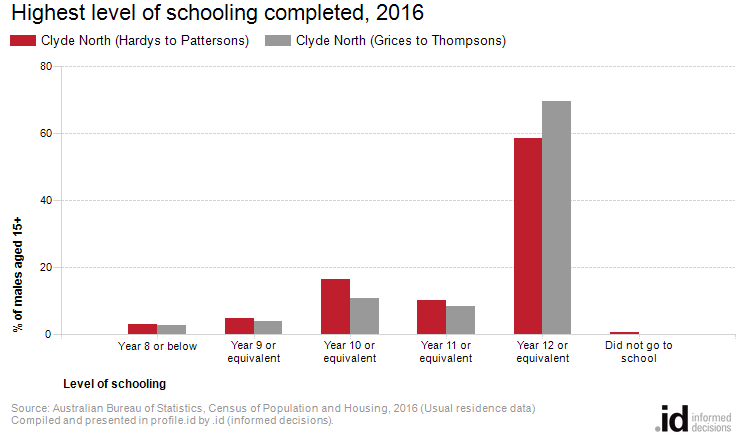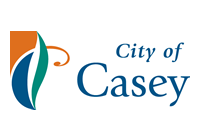Clyde North (Hardys to Pattersons)
Highest level of schooling
In Clyde North (Hardys to Pattersons), 58.5% of males aged over 15 years had completed Year 12 schooling (or equivalent) as of 2016. This was less than Clyde North (Grices to Thompsons).
Clyde North (Hardys to Pattersons)'s school completion data is a useful indicator of socio-economic status. With other indicators, such as Proficiency in English, the data informs planners and decision-makers about people's ability to access services. Combined with Educational Qualifications it also allows assessment of the skill base of the population.
Derived from the Census question:
'What is the highest year of primary or secondary school the person has completed?'
Persons aged 15 years and over
| Highest level of secondary schooling completed | ||||||||
|---|---|---|---|---|---|---|---|---|
| Clyde North (Hardys to Pattersons) - Total males (Usual residence) | 2016 | 2011 | Change | |||||
| Level of schooling | Number | % | Clyde North (Grices to Thompsons) % | Number | % | Clyde North (Grices to Thompsons) % | 2011 to 2016 | |
| Year 8 or below | 43 | 3.1 | 2.6 | 6001 | 1 | 4.3 | 4.3 | +42 |
| Year 9 or equivalent | 68 | 4.8 | 3.9 | 6002 | 3 | 8.3 | 8.3 | +65 |
| Year 10 or equivalent | 234 | 16.6 | 10.8 | 6003 | 7 | 19.5 | 19.5 | +227 |
| Year 11 or equivalent | 142 | 10.1 | 8.4 | 6004 | 5 | 13.8 | 13.8 | +138 |
| Year 12 or equivalent | 828 | 58.5 | 69.8 | 6005 | 18 | 47.0 | 47.0 | +810 |
| Did not go to school | 9 | 0.6 | -- | 6006 | 0 | 0.0 | 0.8 | +9 |
| Not stated | 90 | 6.4 | 4.5 | 6007 | 2 | 6.3 | 6.3 | +88 |
| Total persons aged 15+ | 1,416 | 100.0 | 100.0 | 39 | 100.0 | 100.0 | +1,378 | |
Source: Australian Bureau of Statistics, Census of Population and Housing (opens a new window) 2011 and 2016. Compiled and presented by .id (opens a new window)(informed decisions).

Compiled and presented in profile.id by .id (informed decisions).

Compiled and presented in profile.id by .id (informed decisions).
Dominant groups
Analysis of the highest level of schooling attained by the male population in Clyde North (Hardys to Pattersons) in 2016 compared to Clyde North (Grices to Thompsons) shows that there was a higher proportion of males who had left school at an early level (Year 10 or less) and a lower proportion of males who completed Year 12 or equivalent.
Overall, 25.1% of the male population left school at Year 10 or below, and 58.5% went on to complete Year 12 or equivalent, compared with 17.3% and 69.8% respectively for Clyde North (Grices to Thompsons).
The major differences between the level of schooling attained by the male population in Clyde North (Hardys to Pattersons) and Clyde North (Grices to Thompsons) were:
- A larger percentage of males who completed year 10 or equivalent (16.6% compared to 10.8%)
- A larger percentage of males who completed year 11 or equivalent (10.1% compared to 8.4%)
- A smaller percentage of males who completed year 12 or equivalent (58.5% compared to 69.8%)
Emerging groups
The largest changes in the level of schooling attained by the male population in Clyde North (Hardys to Pattersons), between 2011 and 2016 were:
- Year 12 or equivalent (+810 males)
- Year 10 or equivalent (+227 males)
- Year 11 or equivalent (+138 males)
- Year 9 or equivalent (+65 males)
